What is a skin biopsy?
A skin biopsy is the removal of a sample of skin. It is usually carried out using a local anesthetic injection into the skin to numb the area. The injection stings temporarily. After the procedure, a suture or bandage may be applied to the biopsy site.
Why have a skin biopsy?
A skin biopsy may be considered necessary as part of the diagnostic process. The additional information obtained from the biopsy can help identify diagnostic clues that are invisible to the naked eye.
Types of skin biopsy
Puncture biopsy
Puncture biopsy
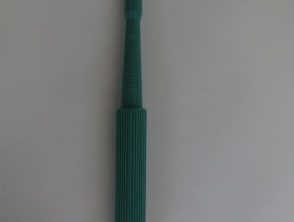
3mm biopsy punch
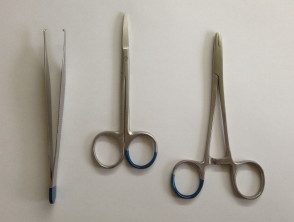
Instrument set
Needle biopsy is generally the most useful type of biopsy. It's quick to perform, convenient, and only produces a small wound. Creates a full-thickness skin swatch that allows pathologist to get a good overview of the epidermis, dermis, and most of the time, the subcutis further.
A disposable skin biopsy punch is used, which has a round stainless steel blade 2 to 6 mm in diameter. 3mm and 4mm punches are the most common sizes used. The clinician holds the instrument perpendicular to the anesthetized skin and rotates it to pierce the skin. Using forceps and scissors, the skin sample is removed.
A suture can be used to close a biopsy puncture or help control bleeding If the wound is small, it can heal properly without it.
Shaving biopsy
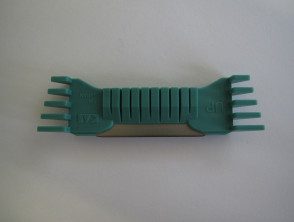
Shave biopsy instrument
A shaving biopsy may be used if the skin injury is superficial, for example, to confirm a suspected diagnosis of intraepidermal carcinoma or basal cell carcinoma
The skin is tangentially shaved with a scalpel, a special shaving biopsy instrument, or a razor blade. No stitches are required. The wound forms a scab that should heal in 1–3 weeks.
Since a shave biopsy does not include the full thickness of the skin, the drawback of such a biopsy is that it can be difficult for a pathologist to rule out or identify invader disease.
A shovel biopsy is a deep form of shave biopsy, used to remove a skin lesion, such as a benign mole "taking it out." Also called "saucer" or "tangential excision". Due to the increased depth, this type of shave biopsy can lead to more extensive scars if allowed to heal by second intention. In some cases, it may require stitches afterward.
Curettage
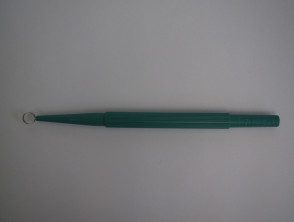
7mm curette
A curette can be used to scrape off a superficial skin lesion, such as a seborrheic keratosis. Some of the legumes are sent for histopathology. These samples are not suitable for determining whether a lesion has been completely removed.
Incisional biopsy
Incisional biopsies refer to removal of a larger and generally deeper ellipse of skin, using a scalpel blade. Stitches are generally required after an incisional biopsy. This type of biopsy can be helpful in providing a better overview to the pathologist, which can improve the accuracy of the diagnosis. It can also be helpful when deeper layers or tissues are believed to be involved in the disease process (e.g, subcutaneous fat or medium blood vessels)
Excisional biopsy
Excisional biopsy refers to the complete removal of a skin lesion, such as a skin Cancer in which a margin is taken from the surrounding skin to improve the chances of complete removal. Smaller lesions are most often removed using a scalpel blade like an ellipse, with primary closure with sutures. Larger splits can be repaired with a flap of skin (moving adjacent skin to cover the wound) or graft (skin taken from another site to patch the wound).
Choosing the type and site for a biopsy
It is crucial that a biopsy site is chosen carefully, or the pathological diagnosis could be incorrect or misleading. Here are some guidelines to help you find the best site, some general tips, and difficulties to avoid, depending on the type of skin injury.
For suspected skin cancer:
- A needle biopsy will usually give the pathologist the best skin sample to determine the growth pattern and depth of invasion. A 3mm punch will suffice in most cases.
- Avoid taking a biopsy from the center of the lesion if it is ulcerated. The wound will be more difficult to suture if it bleeds and the tissue may be heavily necrotic making it difficult to obtain an adequate tissue sample.
- If there is a lot scale present, gently remove this first and take immediate underlying skin biopsy.
- Trying to completely remove skin cancer with a needle biopsy is generally not recommended.
For the majority inflammatory Skin diseases:
- A needle biopsy generally provides a good overview of the entire skin for the pathologist, and a 4mm puncture is generally sufficient.
- As the lesions evolve over time, they will exhibit more (or fewer) useful features over time. histological examination, so when choosing a biopsy site, the age of a lesion is an important aspect to consider.
- When vasculitis The best lesion for biopsy is suspected to be a new one (between 24 and 48 hours old).
- In general, it is best to take a biopsy from the center of a larger, well-developed site. It should be taken from the raised edge of a cancel license plate.
- Avoid areas that are scratched / chafed as they will show nonspecific changes.
- Avoid areas that have been treated with current steroids or others anti-inflammatory agents when possible.
by ulcers, erosions and blisters:
- The skin adjacent to erosions and ulcers generally provides the most useful diagnostic information.
- When there are blisters, it is best to biopsy the edge of a blister, while it includes two-thirds of the normal adjacent skin.
- A small intact vial can display more useful information than the corner of a large one.
- A needle biopsy taken to immunofluorescence purposes are best taken from perilesional skin.
Completing the application form
The clinician must ensure pathology The request form includes basic patient information (including age and identification details), the site and type of biopsy, and the time and date. Left and right are spelled better to avoid mistakes
In addition to this, it is crucial that the pathologist receives clinical information and a variety of possible diagnoses. For the better clinicopathological Correlation clinical information should include a description of duration, symptoms, and a dermatological description.
The sample pot should be labeled with patient identification details, biopsy body site, time and date, and the request form checked for consistency. When multiple biopsies are taken, Roman numerals are best used to match the application forms with their corresponding sample pots.
Application form
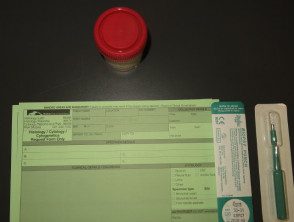
Biopsy form
What happens to the biopsy sample?
Most skin biopsies are placed in formalin in a small pot and sent to the laboratory for fixation, processing, and paraffin. histopathological exam.
- If you consider deep fungus infection or mycobacteria, the sample can be divided so that one part of the sample is sent in formalin for histopathology and the other part is placed in a salineof soaked gauze for microbiology.
- Samples for direct immune fluorescence are placed in transport media, frozen in liquid nitrogen, or shipped "fresh" (eg, placed on a moistened gauze swab in a sterile empty pot).
Complications of skin biopsy.
Skin biopsy is usually straightforward, and complications are rare. As a general rule of thumb, the larger the skin sample removed, the greater the possibility of complications. The following complications can occur.
Bleeding
Intraoperative or postoperative bleeding can occur in anyone, but it can be particularly troublesome in those with a tendency to bleed or taking blood-thinning medications such as warfarin or aspirin.
Infection
Bacterial wound infection affects approximately 1–5% of excisional biopsies. However, it is extremely rare in small incisional perforations, shaves, or biopsies. Ulcerated or crusted skin lesions, the biopsy site, patient characteristics such as diabetes, advanced age, or the use of immunosuppressive medications may all contribute to an increased risk of infection.
Nerve injury
The blade can cut a superficial sensory nerve causing pain or numbness. This is more likely to occur where the skin is thin, for example on the face or the back of the hand. The risk of motor nerve impairment is extremely rare, but it can occur during skin cancer surgery in facial danger zones. These include the temporary, marginal mandibular, zygomatic branches of the facial nerve and the spinal accessory nerve (at Erb's point).
Scars
It is common for a biopsy site to form a significant permanent scar. Some sites on the body, such as the center of the chest, are prone to developing excess or hypertrophic scars This is also more common in Afro-Caribbean skin types.
Persistence or reappearance of the skin lesion
Many biopsies are deliberately partial and are only intended for diagnostic purposes. With excisional biopsies, there is a risk of not removing the entire lesion, which may recur later.
Anesthetic problems
Allergies Local anesthetics are a possibility, but they are also extremely rare. A vasovagal reaction is more common, which can cause the patient to pass out and potentially hurt themselves. Palpitations are another adrenaline-related side effect commonly present in the Local anesthesia.
Wound breakdown
This is a rare complication of sutured wounds. It is more likely to occur in places on the body where there is a lot of scar tension (eg, chest, back), immediately after suture removal or as a result of infection. Avoiding exercise, the use of strips and dissolvable sutures can help prevent this.
Getting the biopsy results
It usually takes about a week or two to get the result from the pathology lab, but it can sometimes take longer if special staining or second opinions are required. The pathologist describes what is seen under the light. microscopy in various sections of the biopsy specimen, and makes a diagnosis or helps to differentiate between the suggested range of clinical diagnoses.
Clinicopathological correlation
Diseases and conditions of the skin can sometimes be very difficult to diagnose accurately. In these cases, the clinical and histopathological findings combined form a more complete picture to make a correct diagnosis. This is called clinicopathologic correlation. Many organizations hold periodic multidisciplinary meetings (MDM) in which a team of experts reviews clinical information, clinical photographs, and pathology slides to determine the best diagnosis and treatment for the patient.
